Upper Elevational Limit of Vegetation in the Himalayas Identified from Landsat Images
Abstract
1. Introduction
2. Materials and Methods
2.1. Datasets
2.2. Vegetation Cover Mapping and Preprocessing
2.3. Edge Detection and Vegetation Lines Identification
| Algorithm 1 Fast tree |
| 1: |
| 2: |
| 3: |
2.4. Validation and Coverage of the Vegetation Lines
3. Results
3.1. Mapping the Vegetation Lines
3.2. Accuracy and Coverage of Vegetation Lines
3.3. Spatial Pattern of Vegetation Lines in the Himalayas
4. Discussion
5. Conclusions
Author Contributions
Funding
Data Availability Statement
Acknowledgments
Conflicts of Interest
Appendix A
| Data | Dataset Name | Resolution | Year | Data Source | Reference |
|---|---|---|---|---|---|
| DEM | SRTM | 30 m | 2000 | Google Earth Engine (accessed on 1 April 2023) | [49] |
| Remote-sensing images | Landsat 8 Level 2, Collection 2, Tier 1 | 30 m | 2015–2021 (June to September) | Google Earth Engine (accessed on 1 April 2023) | [50] |
| Land cover products | GlobeLand30 | 30 m | 2020 | https://engine.piesat.cn/dataset-list (accessed on 1 May 2023) | [51] |
| ESA WorldCover 10 m v200 | 10 m | 2020 | Google Earth Engine (accessed on 1 May 2023) | [52] | |
| GLC_FCS30 | 30 m | 2021 | https://zenodo.org/records/3986872 (accessed on 1 May 2023) | [53] | |
| FROM-GLC | 30 m | 2017 | https://data-starcloud.pcl.ac.cn/zh (accessed on 1 May 2023) | [54] |
Appendix B
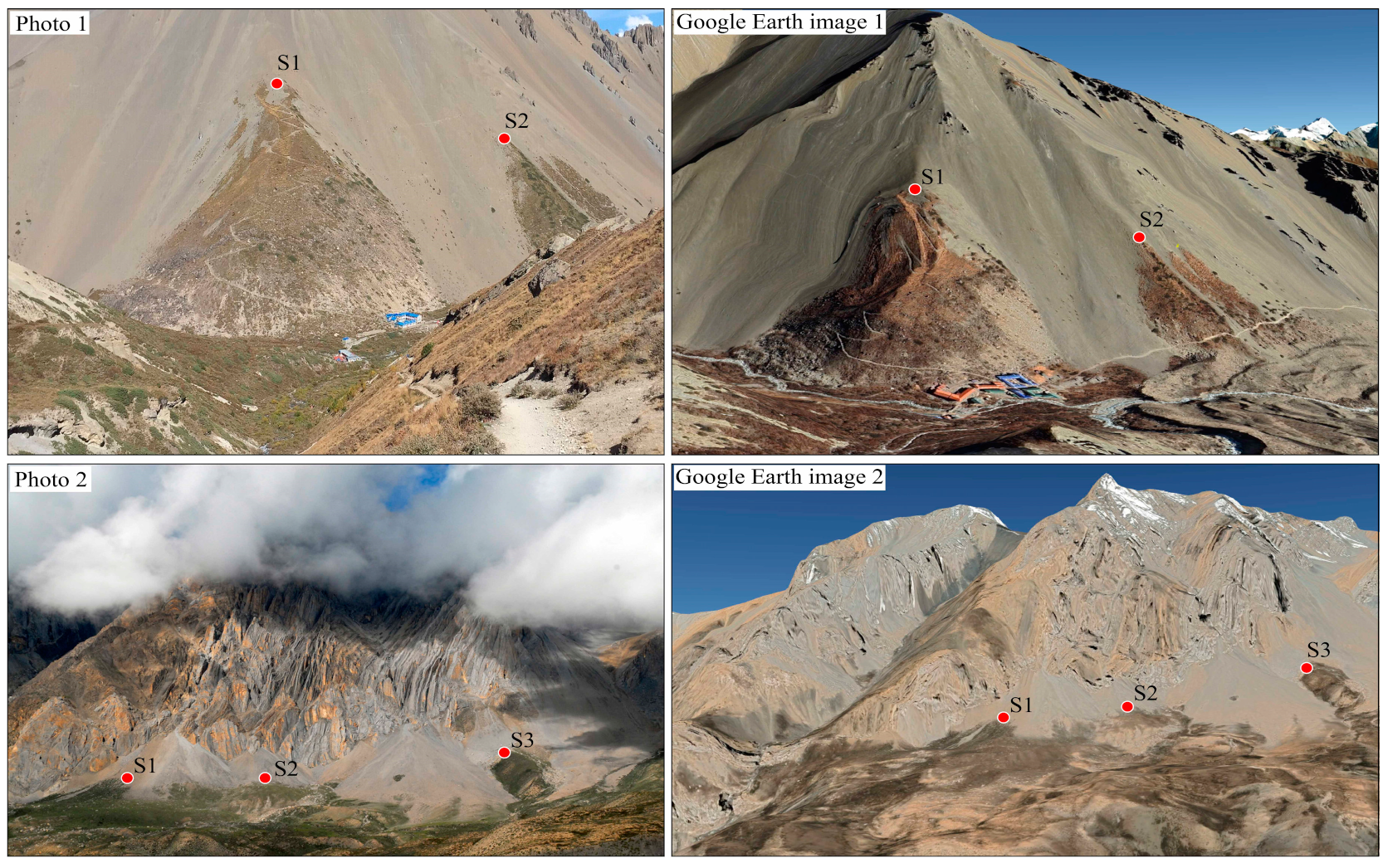
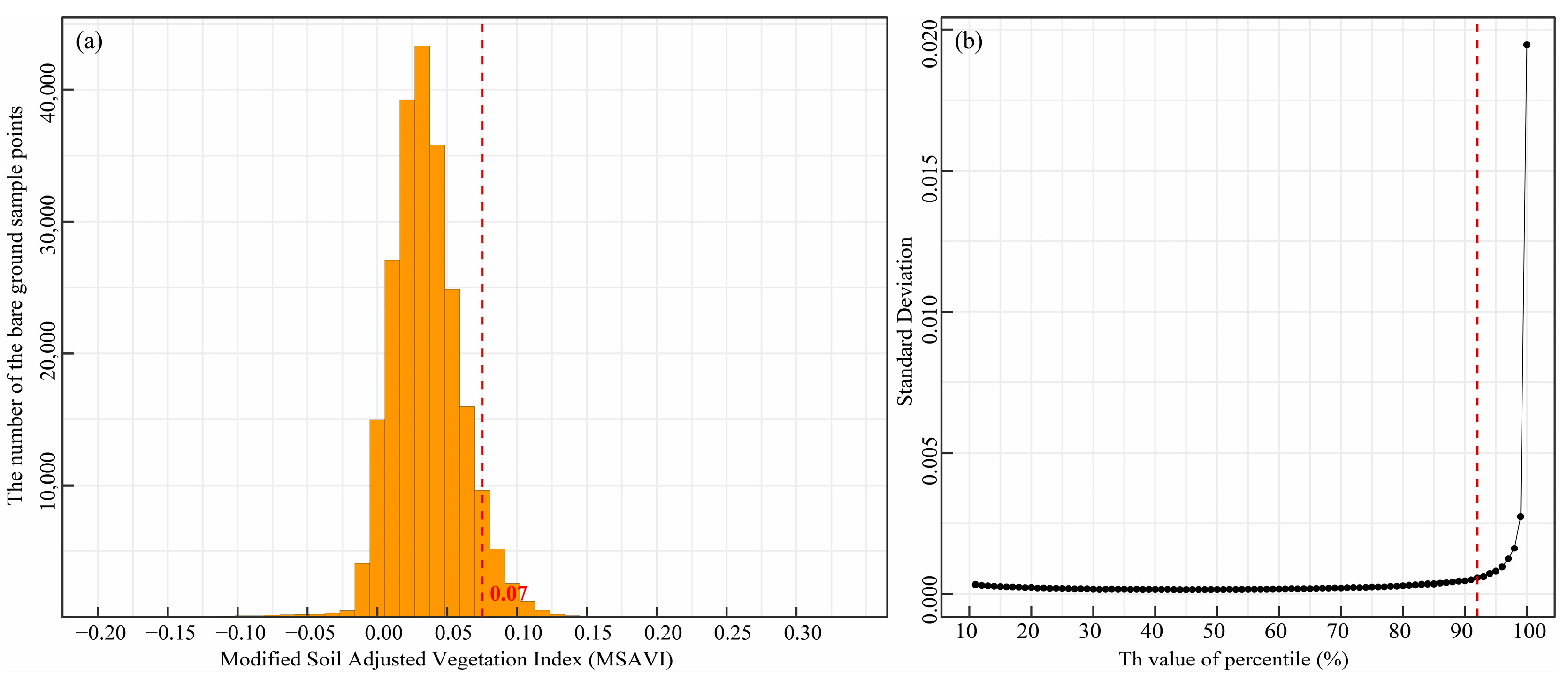
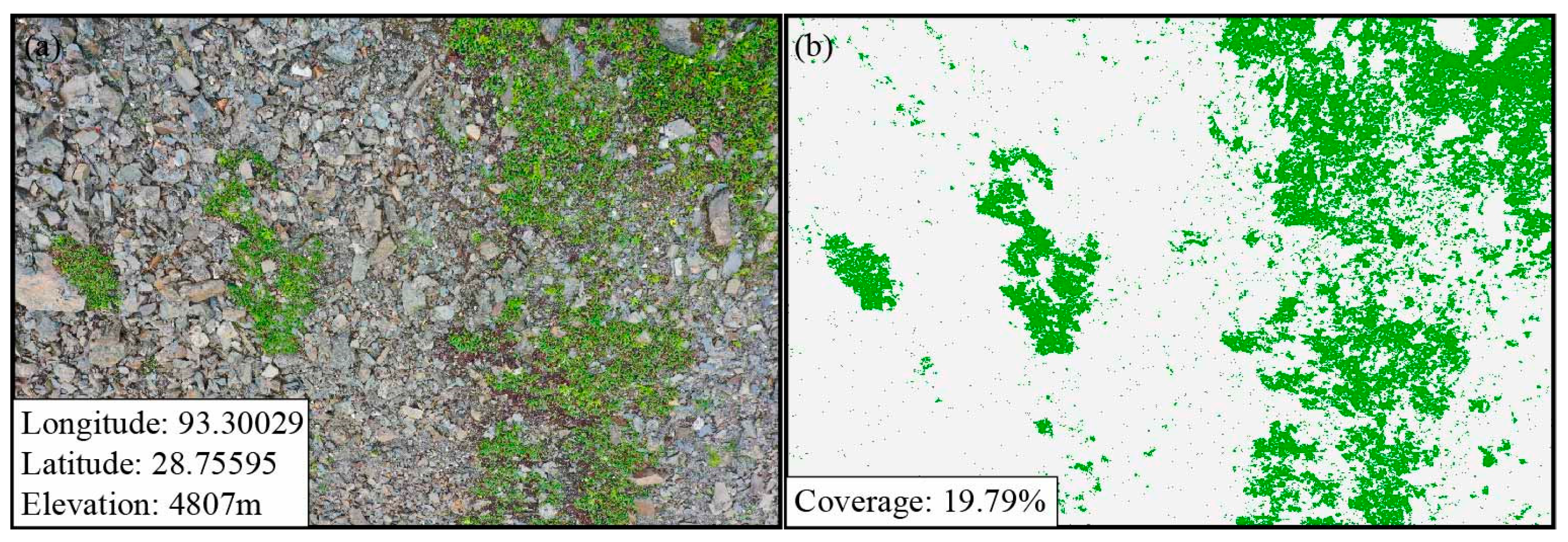

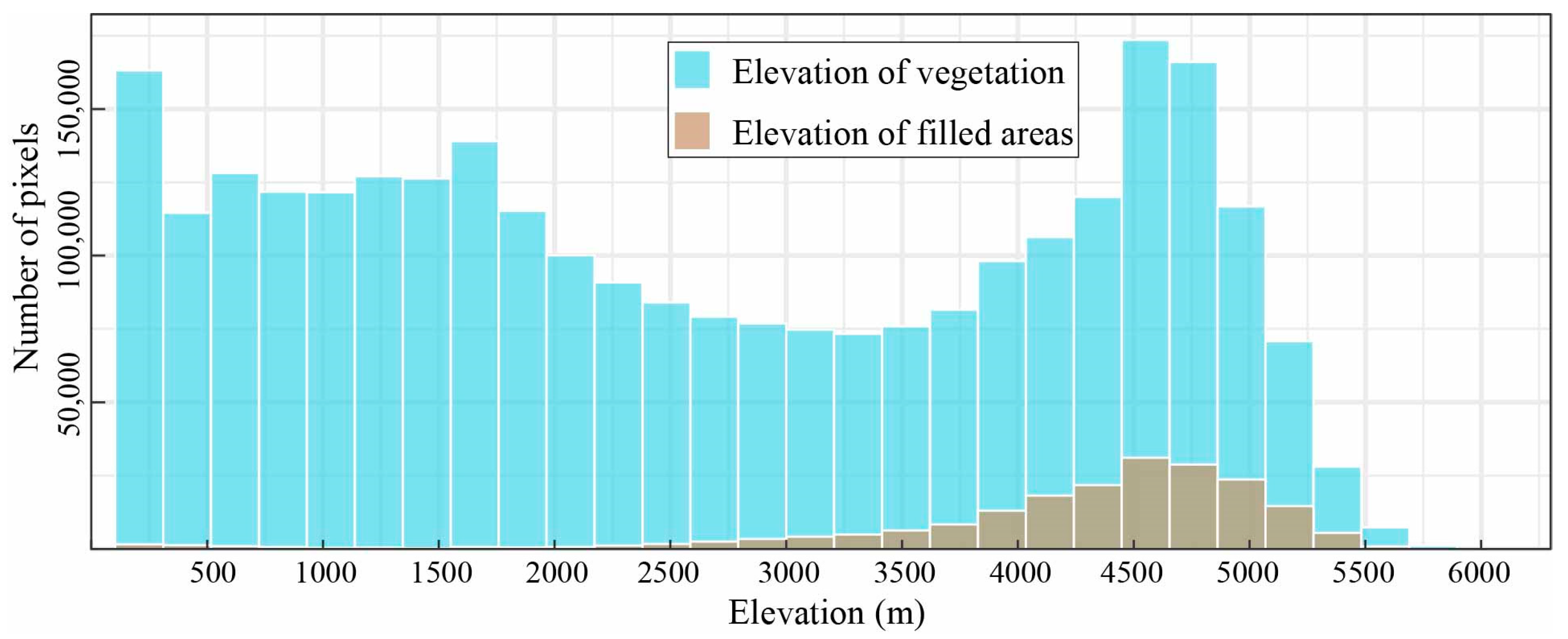
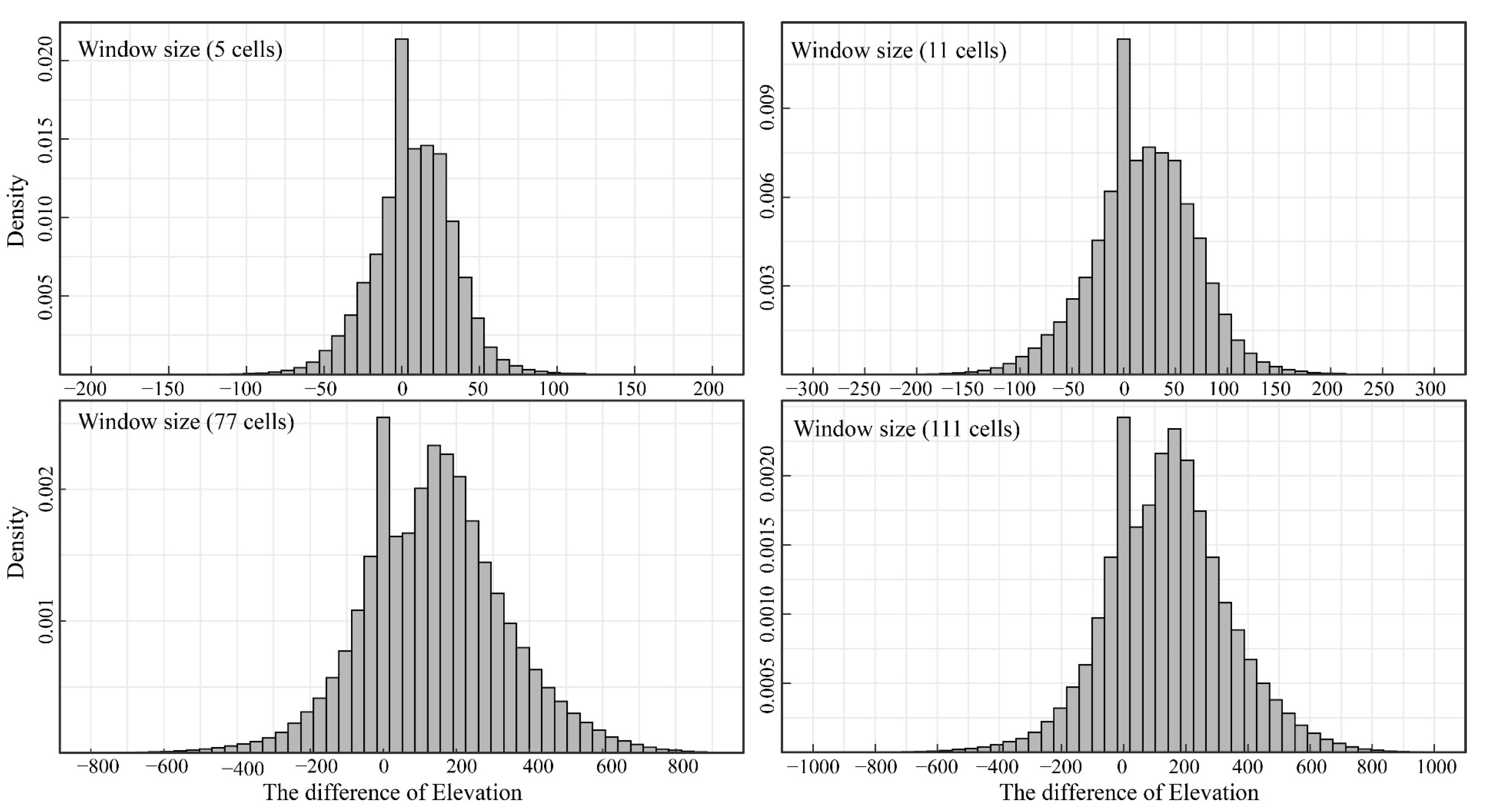
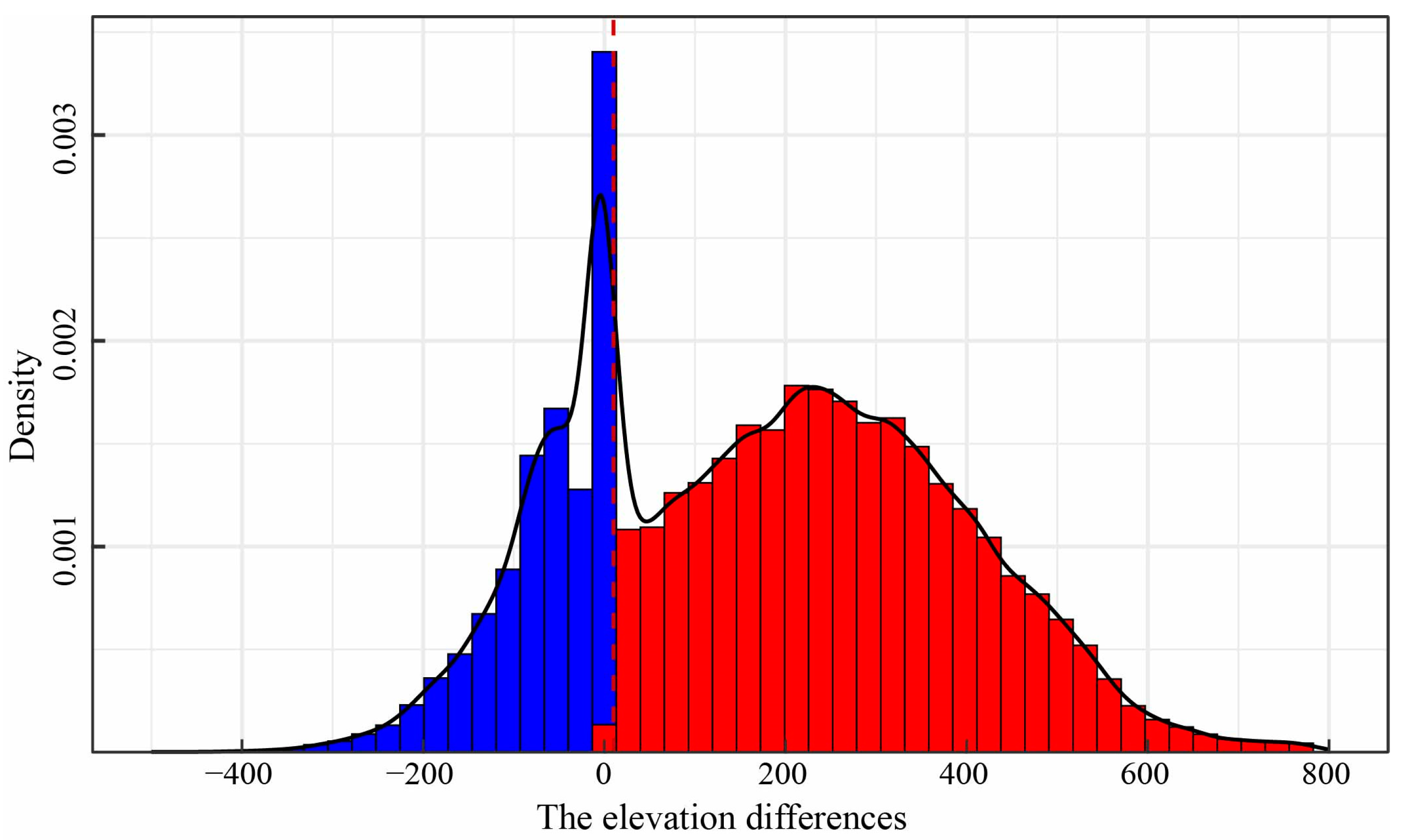
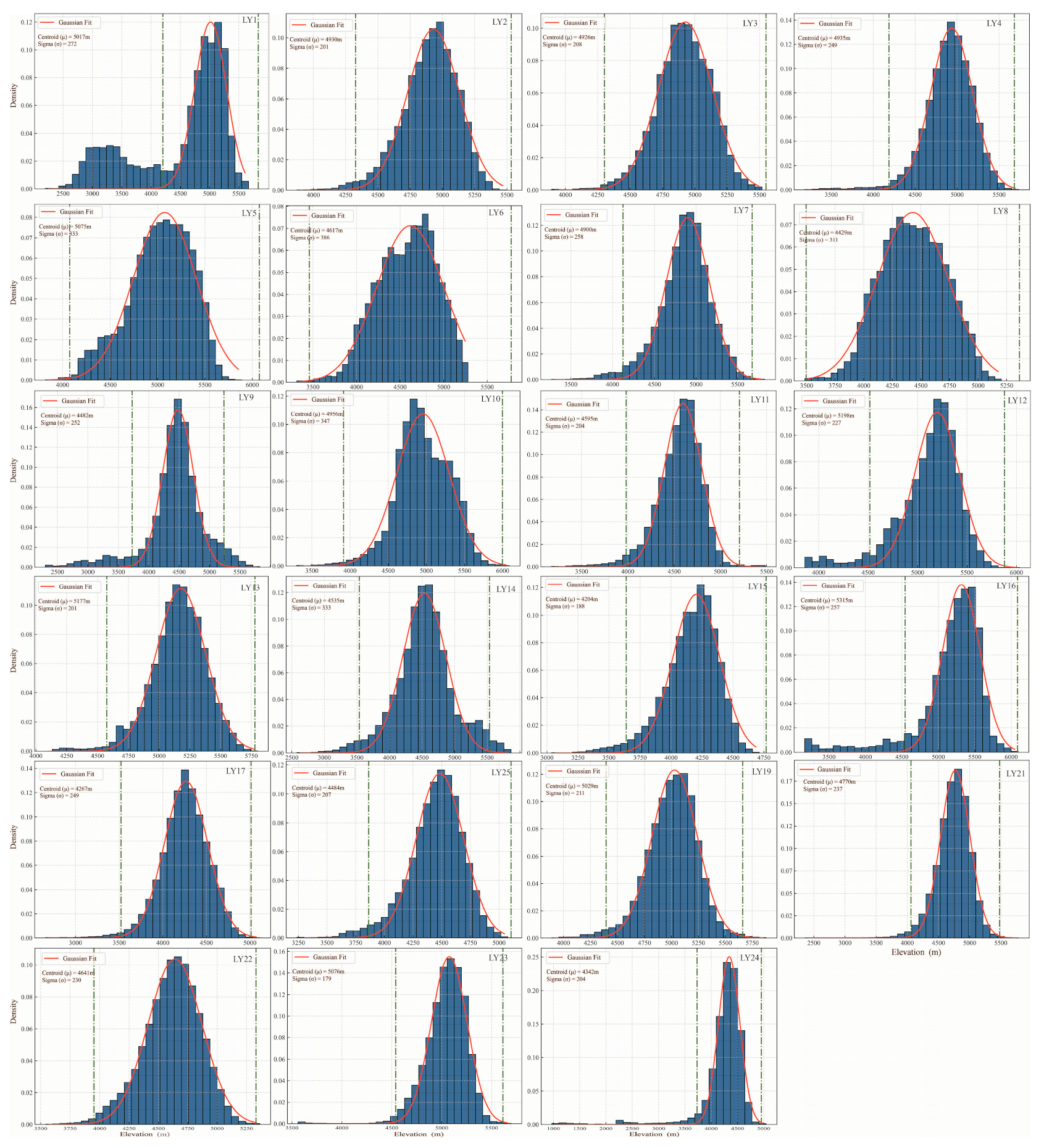

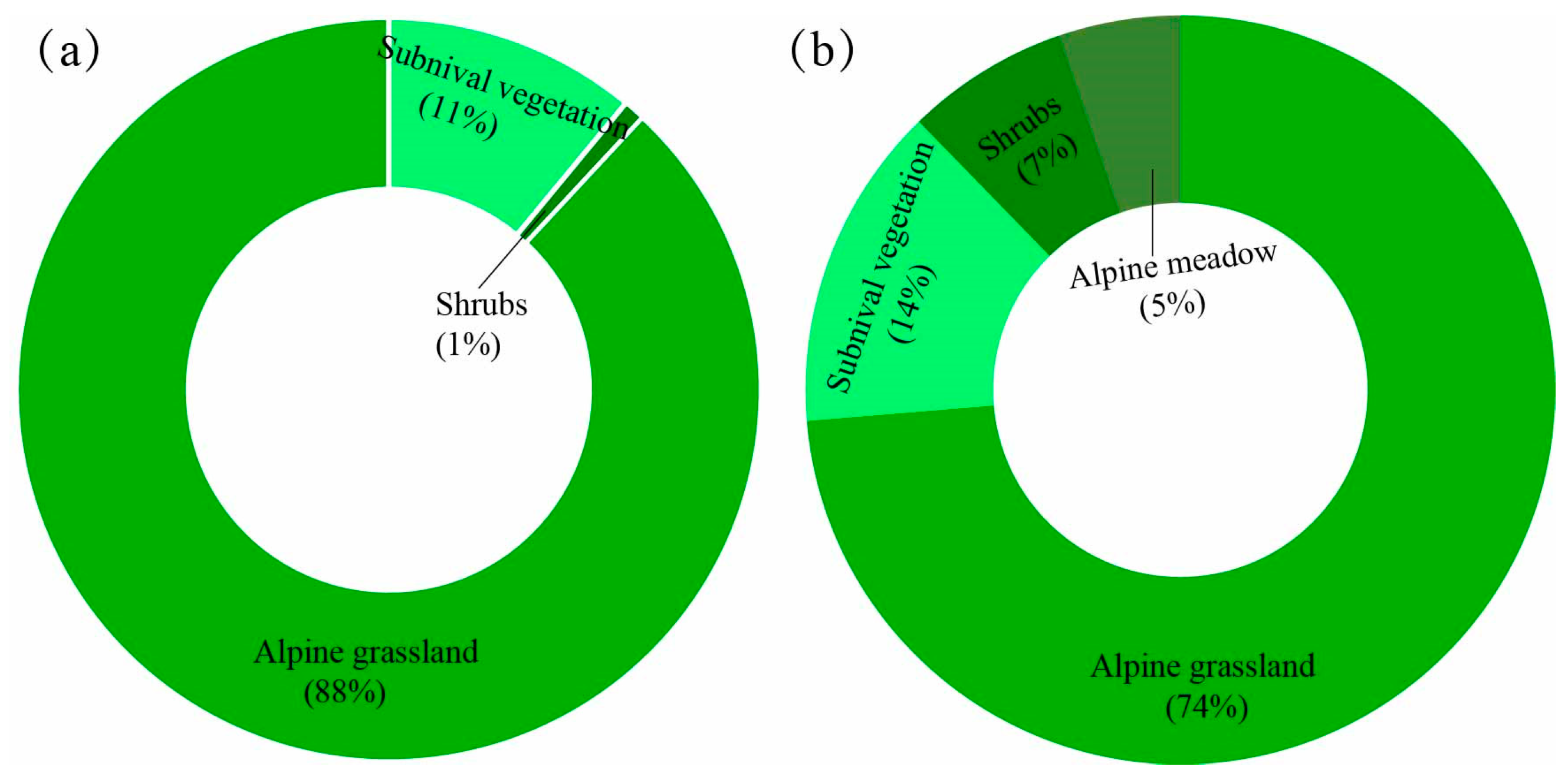
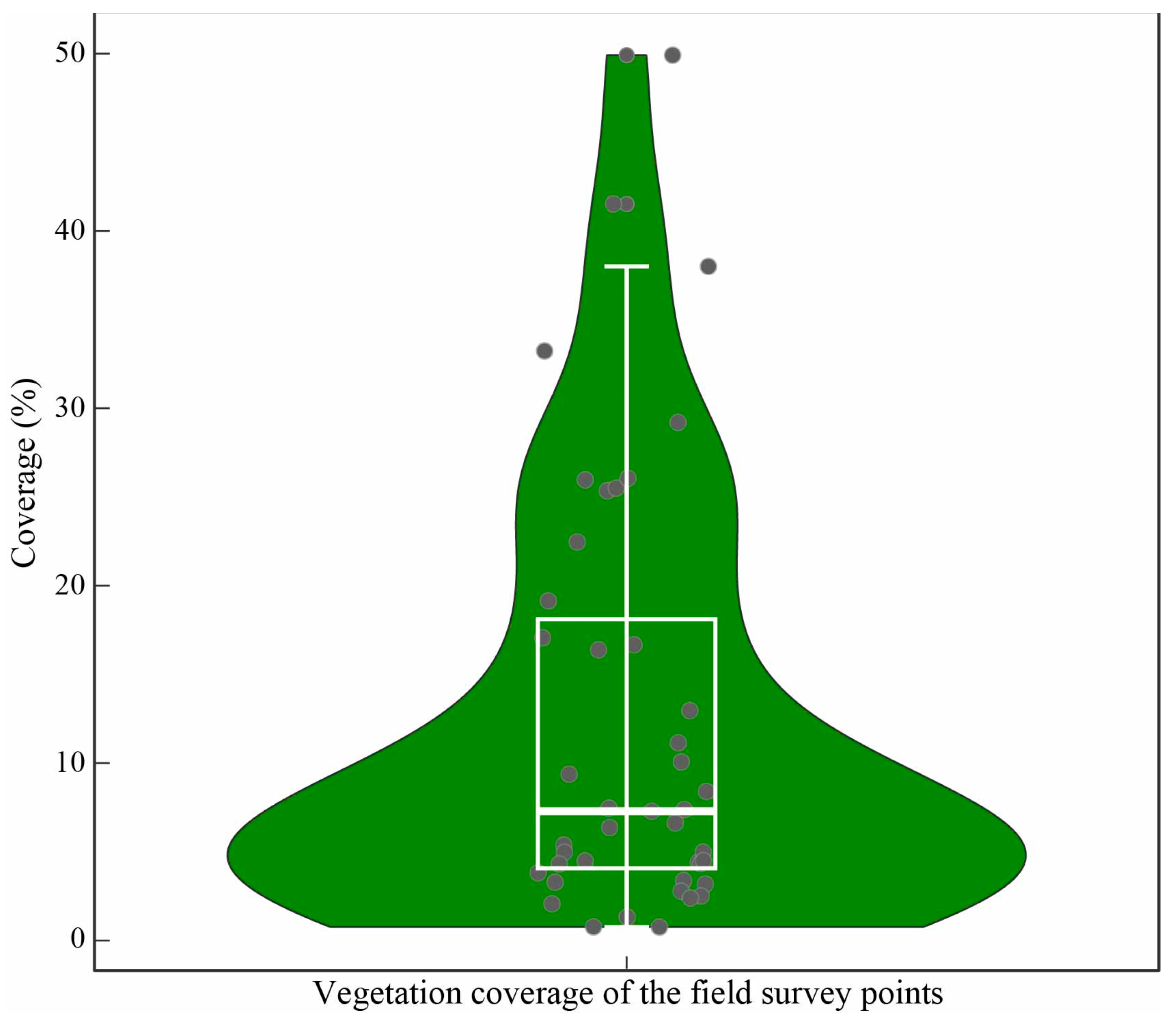
References
- Bürli, S.; Theurillat, J.-P.; Winkler, M.; Lamprecht, A.; Pauli, H.; Rixen, C.; Steinbauer, K.; Wipf, S.; Abdaladze, O.; Andrews, C.; et al. A common soil temperature threshold for the upper limit of alpine grasslands in European mountains. Alp. Botany 2021, 131, 41–52. [Google Scholar] [CrossRef]
- Lamprecht, A.; Semenchuk, P.R.; Steinbauer, K.; Winkler, M.; Pauli, H. Climate Change Leads to Accelerated Transformation of High-elevation Vegetation in the Central Alps. New Phytol. 2018, 220, 447–459. [Google Scholar] [CrossRef]
- Zu, K.; Wang, Z.; Zhu, X.; Lenoir, J.; Shrestha, N.; Lyu, T.; Luo, A.; Li, Y.; Ji, C.; Peng, S. Upward Shift and Elevational Range Contractions of Subtropical Mountain Plants in Response to Climate Change. Sci. Total Environ. 2021, 783, 146896. [Google Scholar] [CrossRef] [PubMed]
- He, X.; Jiang, X.; Spracklen, D.V.; Holden, J.; Liang, E.; Liu, H.; Xu, C.; Du, J.; Zhu, K.; Elsen, P.R. Global Distribution and Climatic Controls of Natural Mountain Treelines. Glob. Change Biol. 2023, 29, 7001–7011. [Google Scholar] [CrossRef] [PubMed]
- Zhu, K.; Song, Y.; Lesage, J.C.; Luong, J.C.; Bartolome, J.W.; Chiariello, N.R.; Dudney, J.; Field, C.B.; Hallett, L.M.; Hammond, M. Rapid Shifts in Grassland Communities Driven by Climate Change. Nat. Ecol. Evol. 2024, 8, 2252–2264. [Google Scholar] [CrossRef] [PubMed]
- Zu, K.; Wang, Z. Research Progress on the Elevational Distribution of Mountain Species in Response to Climate Change. Biodivers. Sci. 2022, 30, 21451. [Google Scholar] [CrossRef]
- Rehm, E.M.; Olivas, P.; Stroud, J.; Feeley, K.J. Losing Your Edge: Climate Change and the Conservation Value of Range-edge Populations. Ecol. Evol. 2015, 5, 4315–4326. [Google Scholar] [CrossRef]
- Wang, X.; Wang, T.; Xu, J.; Shen, Z.; Yang, Y.; Chen, A.; Wang, S.; Liang, E.; Piao, S. Enhanced Habitat Loss of the Himalayan Endemic Flora Driven by Warming-Forced Upslope Tree Expansion. Nat. Ecol. Evol. 2022, 6, 890–899. [Google Scholar] [CrossRef]
- Körner, C.; Hoch, G. Not Every High-latitude or High-elevation Forest Edge Is a Treeline. J. Biogeogr. 2023, 50, 838–845. [Google Scholar] [CrossRef]
- Dolezal, J.; Dvorsky, M.; Kopecky, M.; Liancourt, P.; Hiiesalu, I.; Macek, M.; Altman, J.; Chlumska, Z.; Rehakova, K.; Capkova, K. Vegetation Dynamics at the Upper Elevational Limit of Vascular Plants in Himalaya. Sci. Rep. 2016, 6, 24881. [Google Scholar] [CrossRef]
- Mountain Research Initiative EDW Working Group. Elevation-Dependent Warming in Mountain Regions of the World. Nat. Clim. Change 2015, 5, 424–430. [Google Scholar] [CrossRef]
- Eichel, J.; Stoffel, M.; Wipf, S. Go or Grow? Feedbacks between Moving Slopes and Shifting Plants in High Mountain Environments. Prog. Phys. Geogr. Earth Environ. 2023, 47, 967–985. [Google Scholar] [CrossRef]
- Liu, L.; Chen, J.; Shen, M.; Chen, X.; Cao, R.; Cao, X.; Cui, X.; Yang, W.; Zhu, X.; Li, L. A Remote Sensing Method for Mapping Alpine Grasslines Based on Graph-cut. Glob. Change Biol. 2024, 30, e17005. [Google Scholar] [CrossRef]
- Zhang, B.; Liu, L.; Zhang, Y.; Wei, B.; Gong, D.; Li, L. Spatial Consistency and Accuracy Analysis of Multi-Source Land Cover Products on the Southeastern Tibetan Plateau, China. Remote Sens. 2024, 16, 3219. [Google Scholar] [CrossRef]
- Zou, L.; Tian, F.; Liang, T.; Eklundh, L.; Tong, X.; Tagesson, T.; Dou, Y.; He, T.; Liang, S.; Fensholt, R. Assessing the Upper Elevational Limits of Vegetation Growth in Global High-Mountains. Remote Sens. Environ. 2023, 286, 113423. [Google Scholar] [CrossRef]
- Barbeito, I.; Dawes, M.A.; Rixen, C.; Senn, J.; Bebi, P. Factors Driving Mortality and Growth at Treeline: A 30-year Experiment of 92 000 Conifers. Ecology 2012, 93, 389–401. [Google Scholar] [CrossRef]
- Sigdel, S.R.; Zheng, X.; Babst, F.; Camarero, J.J.; Gao, S.; Li, X.; Lu, X.; Pandey, J.; Dawadi, B.; Sun, J. Accelerated Succession in Himalayan Alpine Treelines under Climatic Warming. Nat. Plants 2024, 10, 1909–1918. [Google Scholar] [CrossRef]
- Iseli, E.; Chisholm, C.; Lenoir, J.; Haider, S.; Seipel, T.; Barros, A.; Hargreaves, A.L.; Kardol, P.; Lembrechts, J.J.; McDougall, K. Rapid Upwards Spread of Non-Native Plants in Mountains across Continents. Nat. Ecol. Evol. 2023, 7, 405–413. [Google Scholar] [CrossRef]
- Huang, N.; He, J.-S.; Chen, L.; Wang, L. No Upward Shift of Alpine Grassland Distribution on the Qinghai-Tibetan Plateau despite Rapid Climate Warming from 2000 to 2014. Sci. Total Environ. 2018, 625, 1361–1368. [Google Scholar] [CrossRef] [PubMed]
- Yao, T.; Bolch, T.; Chen, D.; Gao, J.; Immerzeel, W.; Piao, S.; Su, F.; Thompson, L.; Wada, Y.; Wang, L. The Imbalance of the Asian Water Tower. Nat. Rev. Earth Environ. 2022, 3, 618–632. [Google Scholar] [CrossRef]
- Dvorský, M.; Chlumská, Z.; Altman, J.; Čapková, K.; Řeháková, K.; Macek, M.; Kopecký, M.; Liancourt, P.; Doležal, J. Gardening in the Zone of Death: An Experimental Assessment of the Absolute Elevation Limit of Vascular Plants. Sci. Rep. 2016, 6, 24440. [Google Scholar] [CrossRef]
- Wu, P.-P.; Wang, Z.; Jia, N.-X.; Dong, S.-Q.; Qu, X.-Y.; Qiao, X.-G.; Liu, C.-C.; Guo, K. Vegetation Classification and Distribution Patterns in the South Slope of Yarlung Zangbo Grand Canyon National Nature Reserve, Eastern Himalayas. Plants 2022, 11, 1194. [Google Scholar] [CrossRef]
- Bhatta, K.P.; Grytnes, J.; Vetaas, O.R. Downhill Shift of Alpine Plant Assemblages under Contemporary Climate and Land-use Changes. Ecosphere 2018, 9, e02084. [Google Scholar] [CrossRef]
- Zhang, Y.L.; Wu, X.; Zheng, D. Vertical Variation of Land Cover in the Central Himalayas. Acta Geogr Sin 2020, 75, 931–948. [Google Scholar] [CrossRef]
- Anderson, K.; Fawcett, D.; Cugulliere, A.; Benford, S.; Jones, D.; Leng, R. Vegetation Expansion in the Subnival Hindu Kush Himalaya. Glob. Change Biol. 2020, 26, 1608–1625. [Google Scholar] [CrossRef]
- Bandyopadhyay, D.; Mukherjee, S.; Singh, G.; Coomes, D. The Rapid Vegetation Line Shift in Response to Glacial Dynamics and Climate Variability in Himalaya between 2000 and 2014. Environ. Monit. Assess. 2023, 195, 70. [Google Scholar] [CrossRef] [PubMed]
- Hamid, M.; Khuroo, A.A.; Malik, A.H.; Ahmad, R.; Singh, C.P.; Dolezal, J.; Haq, S.M. Early Evidence of Shifts in Alpine Summit Vegetation: A Case Study from Kashmir Himalaya. Front. Plant Sci. 2020, 11, 421. [Google Scholar] [CrossRef] [PubMed]
- Canny, J. Collision Detection for Moving Polyhedra. IEEE Trans. Pattern Anal. Mach. Intell. 1986, 2, 200–209. [Google Scholar] [CrossRef] [PubMed]
- Marta, S. Planet Imagery Product Specifications; Planet Labs: San Francisco, CA, USA, 2018; Volume 91, p. 170. [Google Scholar]
- Xie, Y.; Shen, Z.; Wang, T.; Malanson, G.P.; Peñuelas, J.; Wang, X.; Chen, X.; Liang, E.; Liu, H.; Yang, M. Uppermost Global Tree Elevations Are Primarily Limited by Low Temperature or Insufficient Moisture. Glob. Change Biol. 2024, 30, e17260. [Google Scholar] [CrossRef] [PubMed]
- Gandhi, G.M.; Parthiban, S.; Thummalu, N.; Christy, A. Ndvi: Vegetation Change Detection Using Remote Sensing and Gis–A Case Study of Vellore District. Procedia Comput. Sci. 2015, 57, 1199–1210. [Google Scholar] [CrossRef]
- Huang, S.; Tang, L.; Hupy, J.P.; Wang, Y.; Shao, G. A Commentary Review on the Use of Normalized Difference Vegetation Index (NDVI) in the Era of Popular Remote Sensing. J. For. Res. 2021, 32, 1–6. [Google Scholar] [CrossRef]
- Montandon, L.M.; Small, E.E. The Impact of Soil Reflectance on the Quantification of the Green Vegetation Fraction from NDVI. Remote Sens. Environ. 2008, 112, 1835–1845. [Google Scholar] [CrossRef]
- Huete, A.R.; Liu, H.Q.; Batchily, K.V.; Van Leeuwen, W. A Comparison of Vegetation Indices over a Global Set of TM Images for EOS-MODIS. Remote Sens. Environ. 1997, 59, 440–451. [Google Scholar] [CrossRef]
- Pérez, F.L. Biogeomorphological Influence of Slope Processes and Sedimentology on Vascular Talus Vegetation in the Southern Cascades, California. Geomorphology 2012, 138, 29–48. [Google Scholar] [CrossRef]
- Qi, J.; Chehbouni, A.; Huete, A.R.; Kerr, Y.H.; Sorooshian, S. A Modified Soil Adjusted Vegetation Index. Remote Sens. Environ. 1994, 48, 119–126. [Google Scholar] [CrossRef]
- Rondeaux, G.; Steven, M.; Baret, F. Optimization of Soil-Adjusted Vegetation Indices. Remote Sens. Environ. 1996, 55, 95–107. [Google Scholar] [CrossRef]
- Zeng, Y.; Hao, D.; Huete, A.; Dechant, B.; Berry, J.; Chen, J.M.; Joiner, J.; Frankenberg, C.; Bond-Lamberty, B.; Ryu, Y. Optical Vegetation Indices for Monitoring Terrestrial Ecosystems Globally. Nat. Rev. Earth Environ. 2022, 3, 477–493. [Google Scholar] [CrossRef]
- Li, K.; Xu, E. Cropland Data Fusion and Correction Using Spatial Analysis Techniques and the Google Earth Engine. GIScience Remote Sens. 2020, 57, 1026–1045. [Google Scholar] [CrossRef]
- Bradski, G. The Opencv Library. Dr. Dobb’s J. Softw. Tools Prof. Program. 2000, 25, 120–123. [Google Scholar]
- O’Sullivan, C.; Coveney, S.; Monteys, X.; Dev, S. Automated Coastline Extraction Using Edge Detection Algorithms. In Proceedings of the IGARSS 2023—2023 IEEE International Geoscience and Remote Sensing Symposium, Pasadena, CA, USA, 16–21 July 2023; pp. 4135–4138. [Google Scholar]
- Lehner, B.; Grill, G. Global River Hydrography and Network Routing: Baseline Data and New Approaches to Study the World’s Large River Systems. Hydrol. Process. 2013, 27, 2171–2186. [Google Scholar] [CrossRef]
- Meyer, G.E.; Neto, J.C. Verification of Color Vegetation Indices for Automated Crop Imaging Applications. Comput. Electron. Agric. 2008, 63, 282–293. [Google Scholar] [CrossRef]
- Massicotte, P. Imagemetrics: Tools to Calculate Various Image Metrics. R Package Version 1.0. 2012. Available online: https://bitbucket.org/persican/imagemetrics/src/master/ (accessed on 1 December 2023).
- Couet, J.; Marjakangas, E.-L.; Santangeli, A.; Kålås, J.A.; Lindström, Å.; Lehikoinen, A. Short-Lived Species Move Uphill Faster under Climate Change. Oecologia 2022, 198, 877–888. [Google Scholar] [CrossRef] [PubMed]
- Zhen, Z.; Chen, S.; Yin, T.; Chavanon, E.; Lauret, N.; Guilleux, J.; Henke, M.; Qin, W.; Cao, L.; Li, J. Using the Negative Soil Adjustment Factor of Soil Adjusted Vegetation Index (SAVI) to Resist Saturation Effects and Estimate Leaf Area Index (LAI) in Dense Vegetation Areas. Sensors 2021, 21, 2115. [Google Scholar] [CrossRef] [PubMed]
- Ma, Y.; He, T.; McVicar, T.R.; Liang, S.; Liu, T.; Peng, W.; Song, D.-X.; Tian, F. Quantifying How Topography Impacts Vegetation Indices at Various Spatial and Temporal Scales. Remote Sens. Environ. 2024, 312, 114311. [Google Scholar] [CrossRef]
- Ma, J.; Yao, X.; Yuan, C. Characteristics and Formation Mechanism of the Cloud Vertical Structure Over the Southeastern Tibetan Plateau in Summer. Earth Space Sci. 2023, 10, e2022EA002811. [Google Scholar] [CrossRef]
- Farr, T.G.; Kobrick, M. Shuttle Radar Topography Mission Produces a Wealth of Data. Eos Trans. Am. Geophys. Union 2000, 81, 583–585. [Google Scholar] [CrossRef]
- Vermote, E.; Justice, C.; Claverie, M.; Franch, B. Preliminary Analysis of the Performance of the Landsat 8/OLI Land Surface Reflectance Product. Remote Sens. Environ. 2016, 185, 46–56. [Google Scholar] [CrossRef]
- Chen, J.; Chen, J. GlobeLand30: Operational Global Land Cover Mapping and Big-Data Analysis. Sci. China Earth Sci. 2018, 61, 1533–1534. [Google Scholar] [CrossRef]
- Zanaga, D.; Van De Kerchove, R.; Daems, D.; De Keersmaecker, W.; Brockmann, C.; Kirches, G.; Wevers, J.; Cartus, O.; Santoro, M.; Fritz, S. ESA WorldCover 10 m 2021 V200; Zenodo: Geneva, Switzerland, 2022. [Google Scholar] [CrossRef]
- Zhang, X.; Liu, L.; Chen, X.; Gao, Y.; Xie, S.; Mi, J. GLC_FCS30: Global Land-Cover Product with Fine Classification System at 30 m Using Time-Series Landsat Imagery. Earth Syst. Sci. Data 2021, 13, 2753–2776. [Google Scholar] [CrossRef]
- Yu, L.; Du, Z.; Dong, R.; Zheng, J.; Tu, Y.; Chen, X.; Hao, P.; Zhong, B.; Peng, D.; Zhao, J.; et al. FROM-GLC Plus: Toward near Real-Time and Multi-Resolution Land Cover Mapping. GIScience Remote Sens. 2022, 59, 1026–1047. [Google Scholar] [CrossRef]
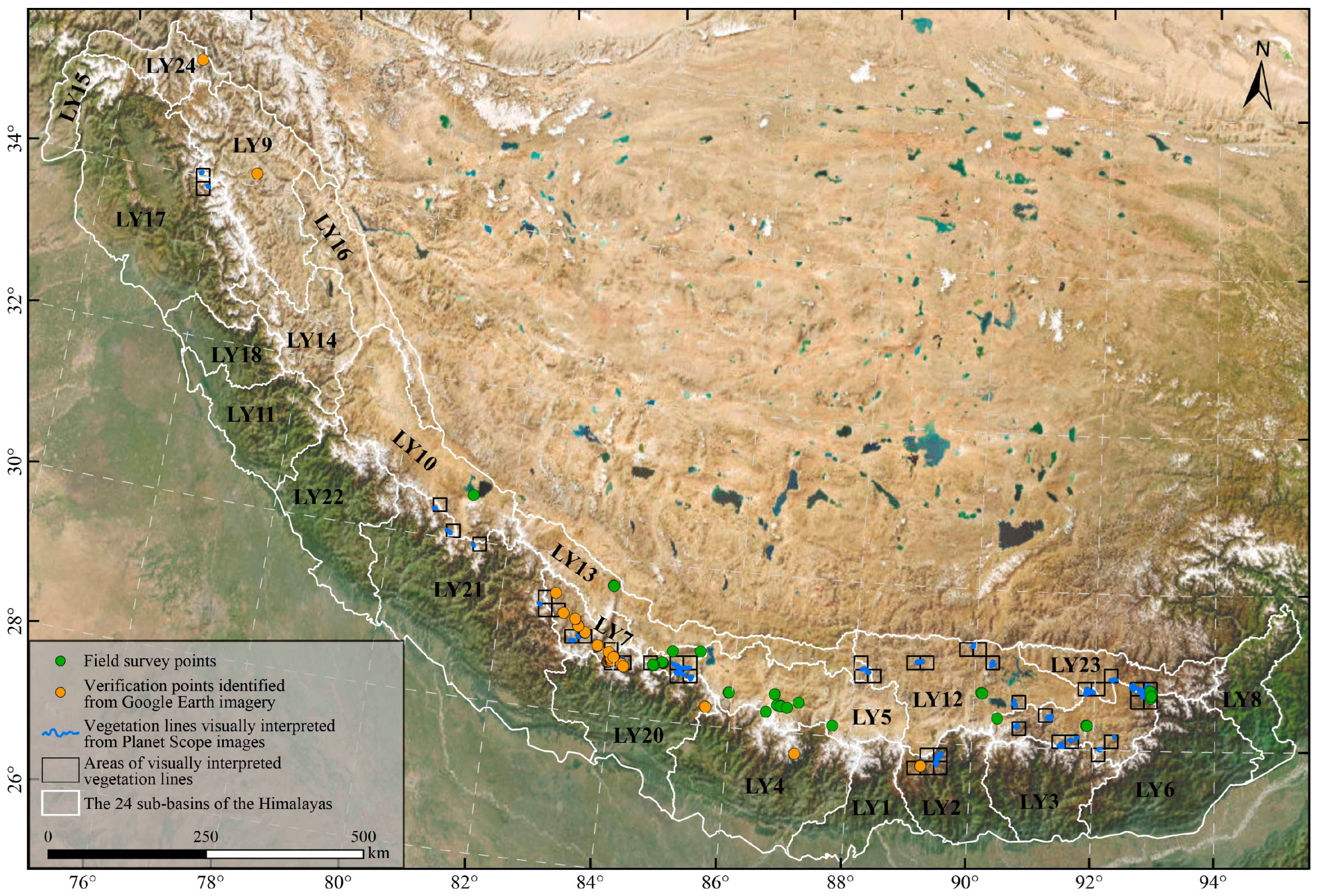
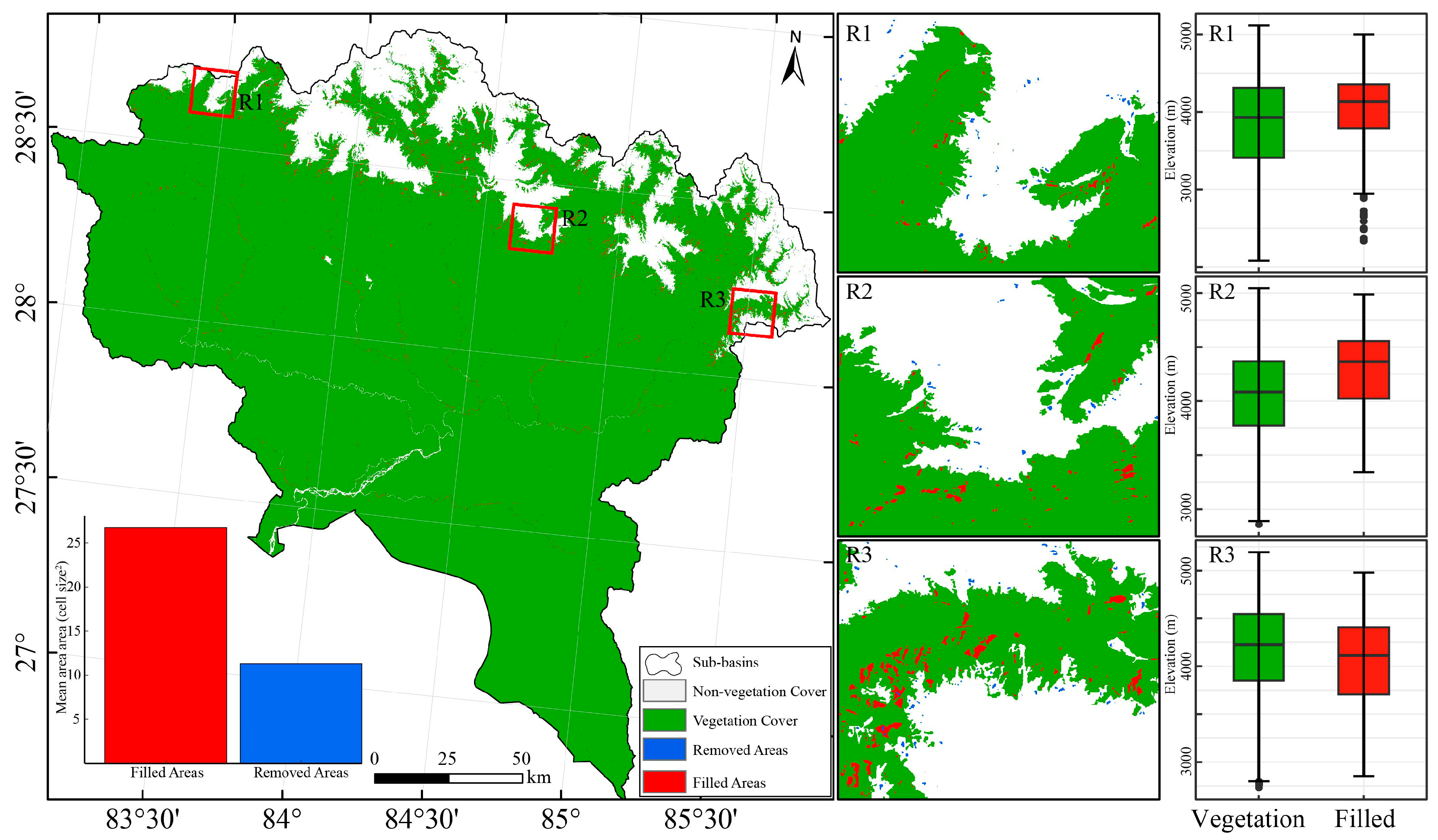
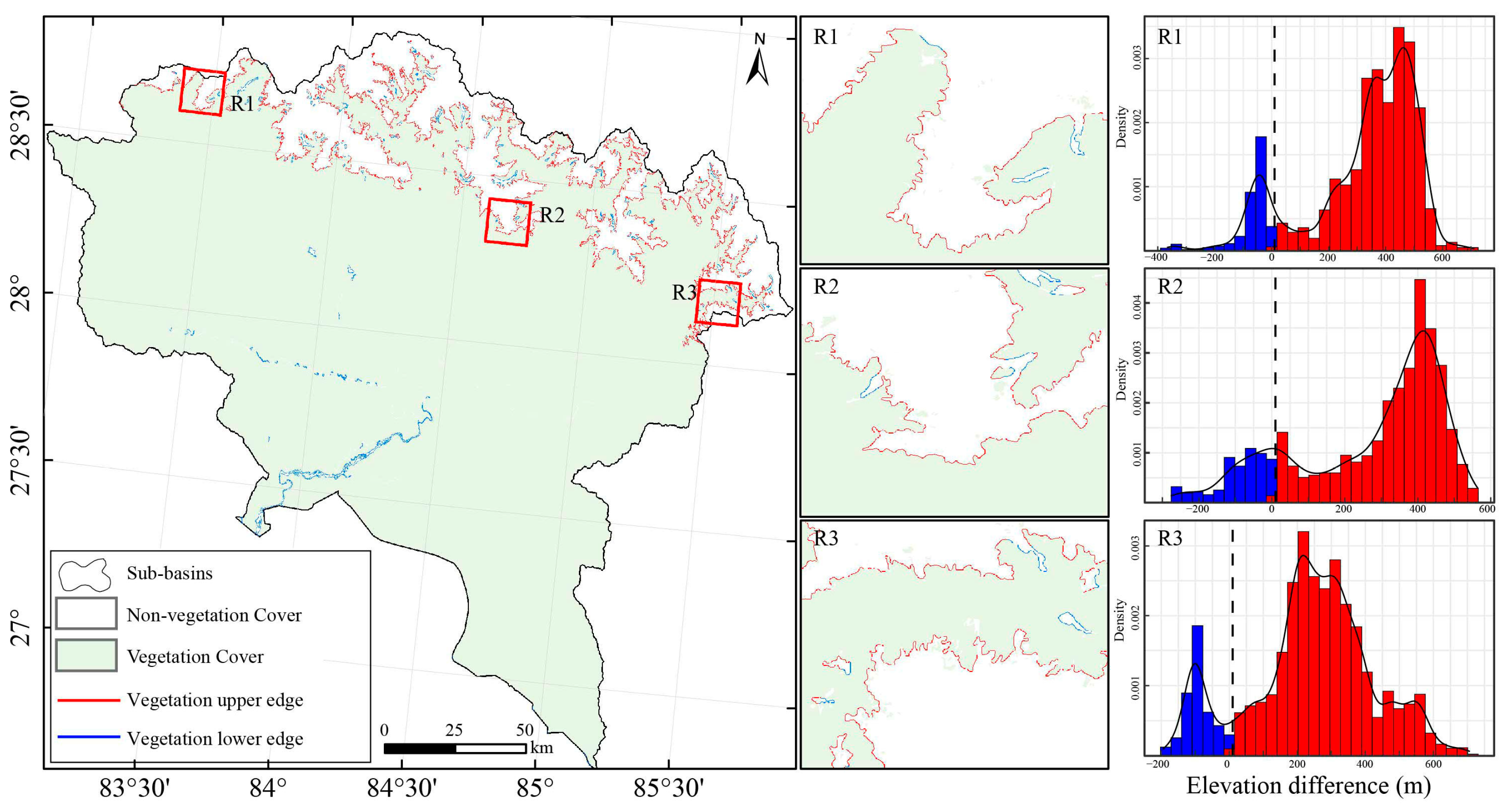
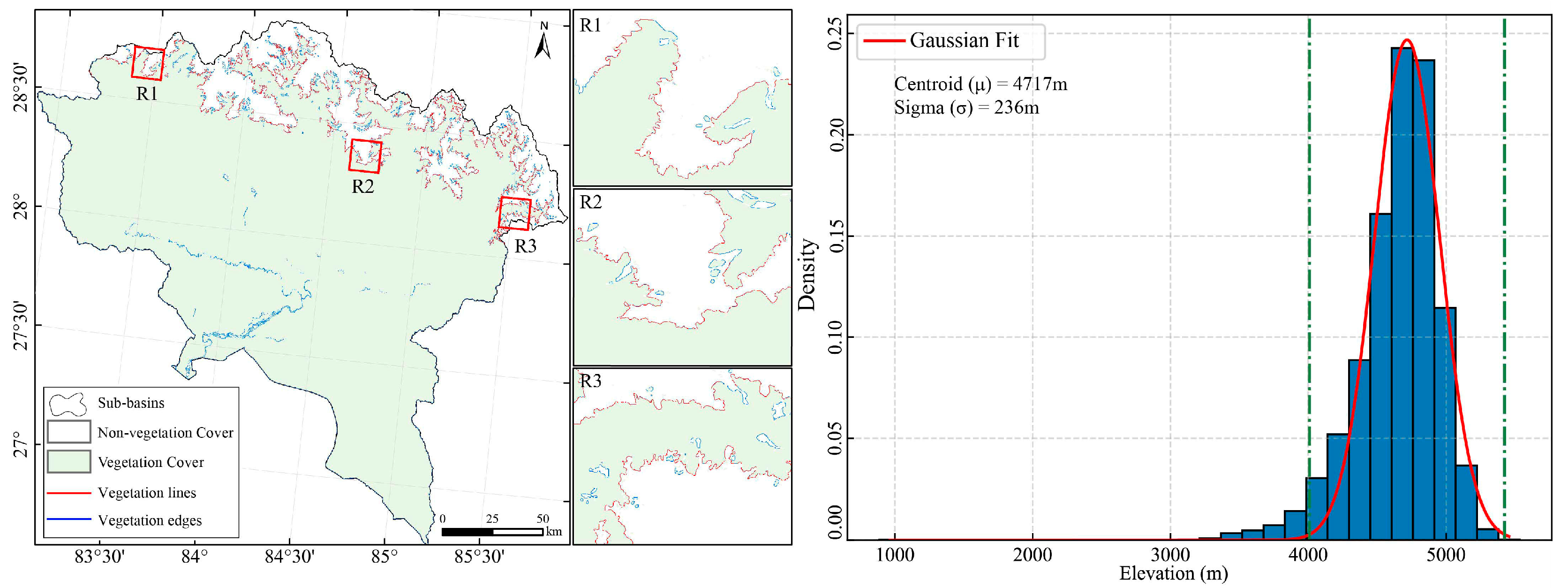

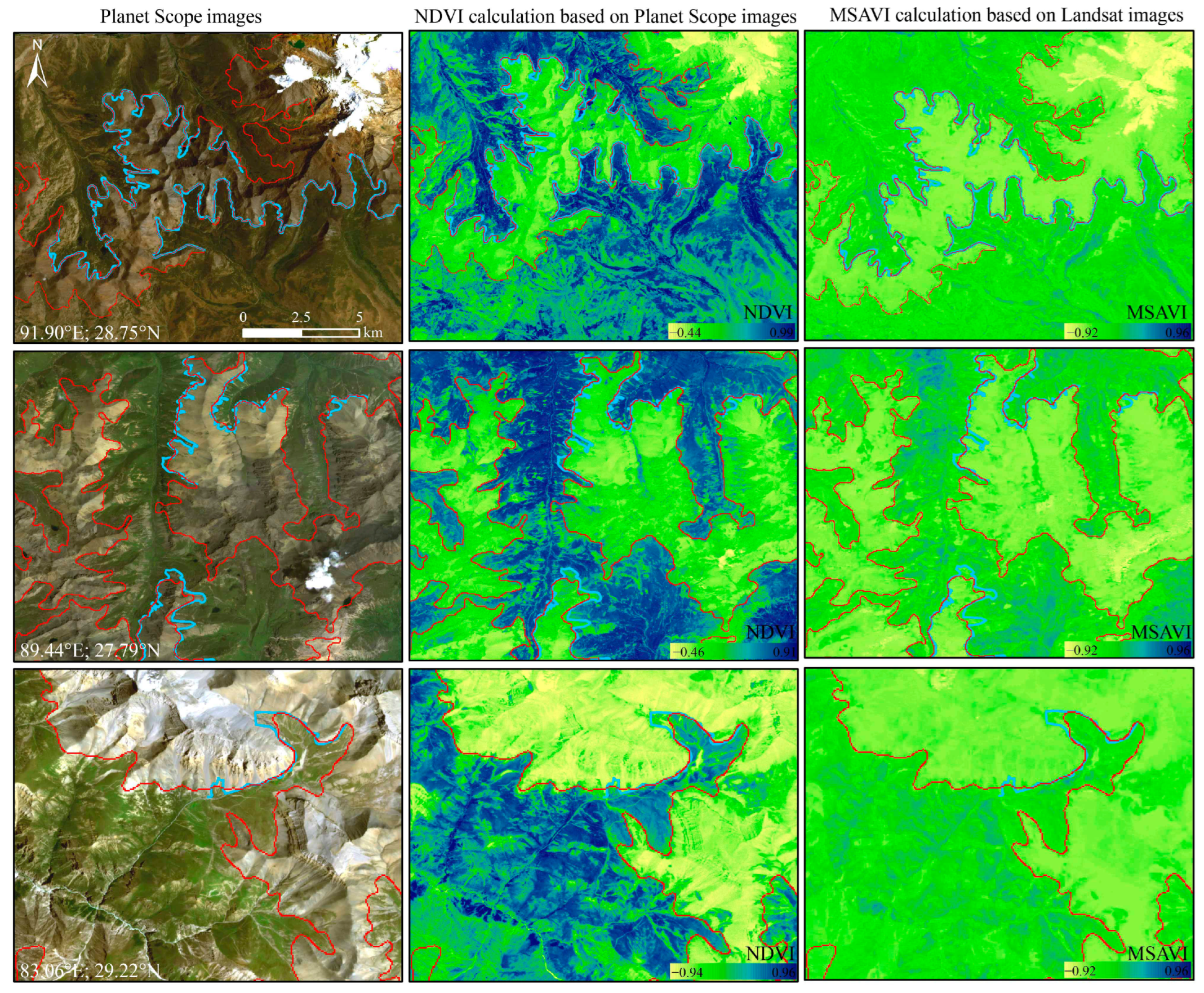
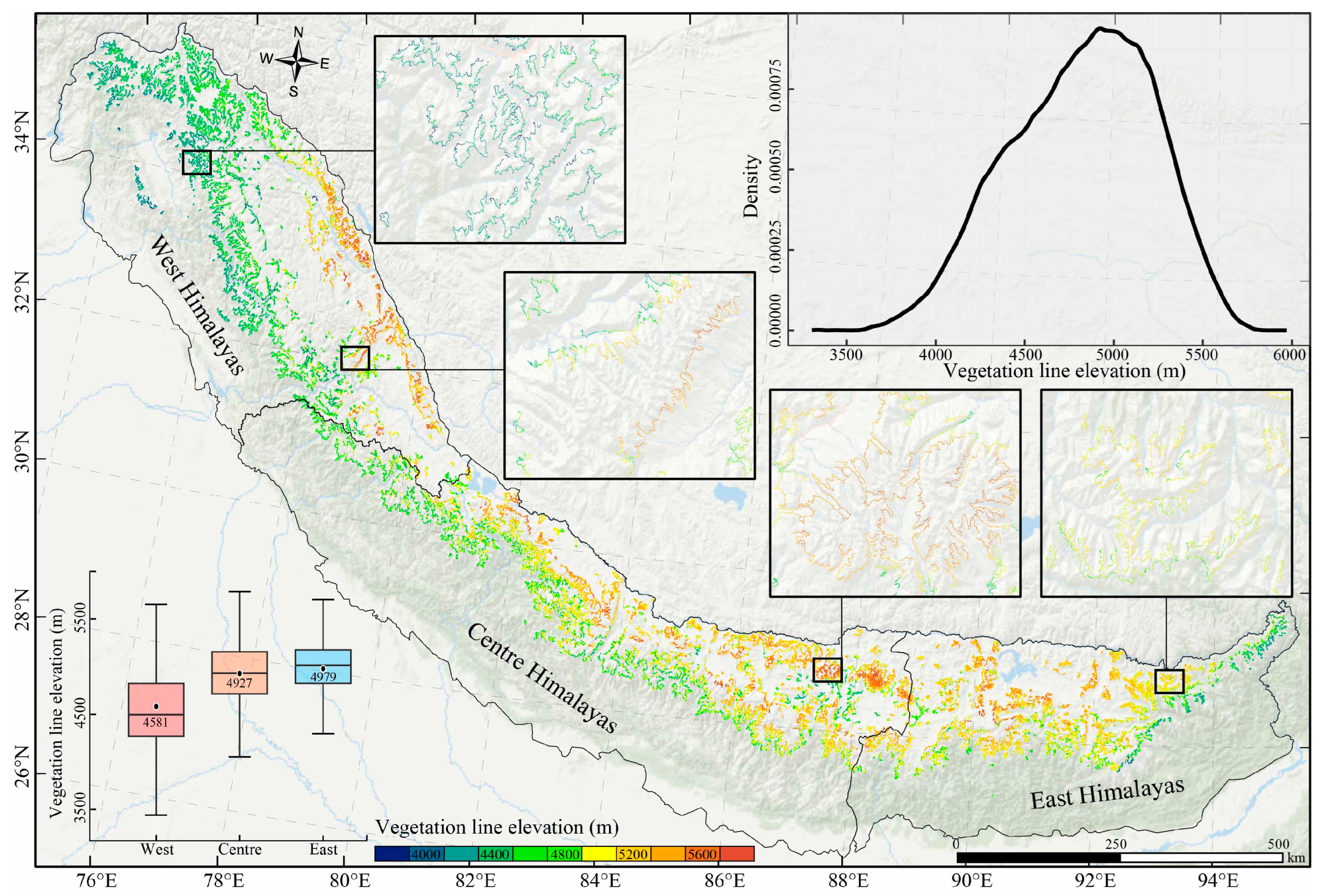
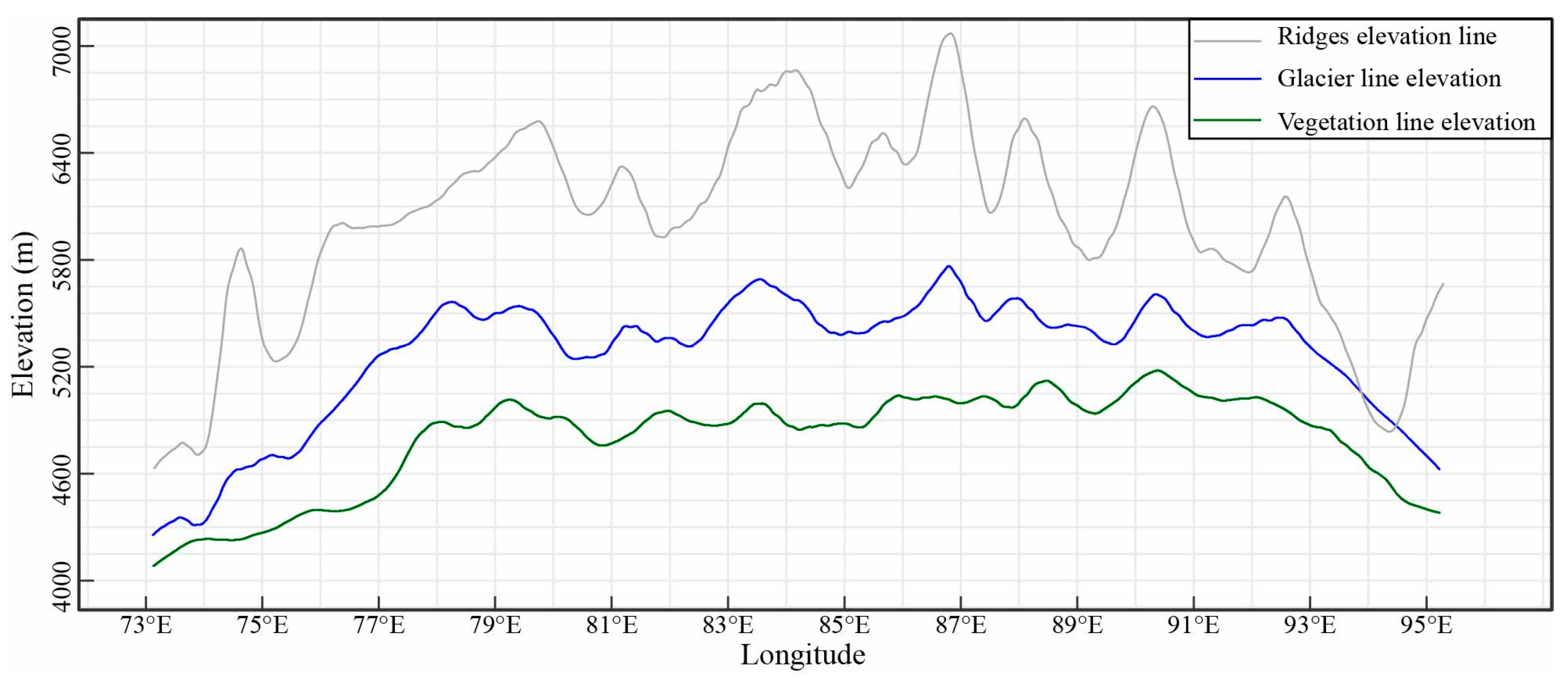
Disclaimer/Publisher’s Note: The statements, opinions and data contained in all publications are solely those of the individual author(s) and contributor(s) and not of MDPI and/or the editor(s). MDPI and/or the editor(s) disclaim responsibility for any injury to people or property resulting from any ideas, methods, instructions or products referred to in the content. |
© 2024 by the authors. Licensee MDPI, Basel, Switzerland. This article is an open access article distributed under the terms and conditions of the Creative Commons Attribution (CC BY) license (https://creativecommons.org/licenses/by/4.0/).
Share and Cite
Wei, B.; Zhang, Y.; Liu, L.; Zhang, B.; Gong, D.; Gu, C.; Li, L.; Paudel, B. Upper Elevational Limit of Vegetation in the Himalayas Identified from Landsat Images. Remote Sens. 2025, 17, 78. https://doi.org/10.3390/rs17010078
Wei B, Zhang Y, Liu L, Zhang B, Gong D, Gu C, Li L, Paudel B. Upper Elevational Limit of Vegetation in the Himalayas Identified from Landsat Images. Remote Sensing. 2025; 17(1):78. https://doi.org/10.3390/rs17010078
Chicago/Turabian StyleWei, Bo, Yili Zhang, Linshan Liu, Binghua Zhang, Dianqing Gong, Changjun Gu, Lanhui Li, and Basanta Paudel. 2025. "Upper Elevational Limit of Vegetation in the Himalayas Identified from Landsat Images" Remote Sensing 17, no. 1: 78. https://doi.org/10.3390/rs17010078
APA StyleWei, B., Zhang, Y., Liu, L., Zhang, B., Gong, D., Gu, C., Li, L., & Paudel, B. (2025). Upper Elevational Limit of Vegetation in the Himalayas Identified from Landsat Images. Remote Sensing, 17(1), 78. https://doi.org/10.3390/rs17010078









